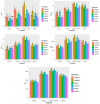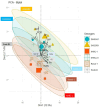Evaluation of drought and salinity tolerance potentials of different soybean genotypes based upon physiological, biochemical, and genetic indicators
- PMID: 39711599
- PMCID: PMC11658995
- DOI: 10.3389/fpls.2024.1466363
Evaluation of drought and salinity tolerance potentials of different soybean genotypes based upon physiological, biochemical, and genetic indicators
Abstract
The present study has evaluated different soybean genotypes to understand the salt and drought tolerance mechanisms based on physiological traits (photosynthesis, stomatal conductance, chlorophyll, and cell membrane stability), antioxidant enzymes (superoxide dismutase, catalase, and peroxidase), reactive oxygen species (H2O2 and O2 •-), osmolytes (glycine betaine, proline, and Na+/K+), plant water relations (relative water content, water potential, and solute potential) and expression of related genes (GmCAT1, GmPOD1, GmSOD, GmP5CS, GmNHX1, GmAKT1, GmDREB1, and GmARF1). The experiment was conducted in a two-factorial arrangement using randomized complete block design (RCBD) with genotypes as one factor and salt, drought, and control treatments as the other factor. All physiological traits, relative water content, and water potential decreased significantly in all soybean genotypes due to individual and combined treatments of drought and salt stress, with significantly less decrease in soybean genotypes G4620RX, DM45X61, and NARC-21. Besides that, the activity of antioxidant enzymes, production of ROS, accumulation of osmolytes, solute potential, and Na+/K+ ratio were increased significantly in all soybean genotypes under salt and water deficit conditions. As a whole, the soybean genotypes G4620RX, DM45X61, and NARC-21 showed the maximum enzymatic activity with less increase in ROS and Na+/K+ in addition to a high accumulation of osmolytes and an increase in solute potential. Correspondingly, the genotypes exhibiting high physiological and biochemical tolerance to drought and salt stresses showed the high expression of genes imparting the stress tolerance. Moreover, correlation, heatmap, and principal component analysis further confirmed the varying physiological and biochemical responses of all soybean genotypes under individual and combined applications of drought and salinity stresses. Overall, the present study confirmed that plants opt for the integrated physiological, biochemical, and genetic approaches to counteract the harmful effects of environmental stresses.
Keywords: antioxidants; gene expression; integrated response; oxidative stress; water relations.
Copyright © 2024 Alzahrani.
Conflict of interest statement
The author declares that the research was conducted in the absence of any commercial or financial relationships that could be construed as a potential conflict of interest.
Figures









Similar articles
-
Physiological, biochemical and molecular evaluation of mungbean genotypes for agronomical yield under drought and salinity stresses in the presence of humic acid.Saudi J Biol Sci. 2022 Sep;29(9):103385. doi: 10.1016/j.sjbs.2022.103385. Epub 2022 Jul 25. Saudi J Biol Sci. 2022. PMID: 35942166 Free PMC article.
-
Comparative adaptability assessment of bread wheat and synthetic hexaploid genotypes under saline conditions using physiological, biochemical, and genetic indices.Front Plant Sci. 2024 Jun 10;15:1336571. doi: 10.3389/fpls.2024.1336571. eCollection 2024. Front Plant Sci. 2024. PMID: 38916034 Free PMC article.
-
Differential response of quinoa genotypes to drought and foliage-applied H2O2 in relation to oxidative damage, osmotic adjustment and antioxidant capacity.Ecotoxicol Environ Saf. 2018 Nov 30;164:344-354. doi: 10.1016/j.ecoenv.2018.08.004. Epub 2018 Aug 18. Ecotoxicol Environ Saf. 2018. PMID: 30130733
-
Separate and combined responses to water deficit and UV-B radiation.Plant Sci. 2013 Dec;213:98-105. doi: 10.1016/j.plantsci.2013.09.003. Epub 2013 Sep 7. Plant Sci. 2013. PMID: 24157212 Review.
-
Improvement of morphophysiological and anatomical attributes of plants under abiotic stress conditions using plant growth-promoting bacteria and safety treatments.PeerJ. 2024 Apr 30;12:e17286. doi: 10.7717/peerj.17286. eCollection 2024. PeerJ. 2024. PMID: 38708356 Free PMC article. Review.
References
-
- Akitha, Devi M. K., Giridhar P. (2015). Variations in physiological response, lipid peroxidation, antioxidant enzyme activities, proline and isoflavones content in soybean varieties subjected to drought stress. PNAS India Sect. B: Biol. Sci. 85, 35–44. doi: 10.1007/s40011-013-0244-0 - DOI
-
- Ali S. G., Rab A. (2017). The influence of salinity and drought stress on sodium, potassium and proline content of Solanum lycopersicum L. cv. Rio grande. Pak. J. Bot. 49, 1–9.
-
- Alici E. H., Arabaci G. (2016). Determination of SOD, POD, PPO and cat enzyme activities in Rumex obtusifolius L. Annu. Res. Rev. Biol. 11, 1–7. doi: 10.9734/ARRB/2016/29809 - DOI
LinkOut - more resources
Full Text Sources
Research Materials

